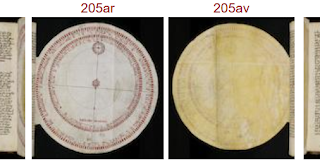The text at left above is rustic capitals, the cursive half-uncial at right is the script of an educated person jotting things fast in Latin in that era. It is named after a former owner, Bernardo Bembo.
The other prominent item is extraordinarily precious to eastern Europe and Russia: the illuminated 11th-century Codex Assemanius, Vat.slav.3, one of the the world's earliest surviving books in the Old Slavonic language, written in the round Glagolitic script. This is a major resource for those interested in the history of the Slavic languages of Europe and of the Slavs' conversion to Christianity.
See the codex's entry in Wikipedia; Glagolitic is the script that probably preceded Cyrillic as the conventional way to record Old Slavonic, but fell into disuse, apart from restricted use in some areas in liturgical books. This book contains readings for mass.
Assessing how many codices are new in this Vatican round is not so easy, since the new posted total has risen 55, yet my software shows 67 additions. I caught at least one case where a codex that was already online in 2013, Vat.lat.3852 (Florus of Lyon), had come back after being missing. My scan shows cases where past duplications have been eliminated, but it all seems rather intractable. Before we make this too complicated, I will offer you the fullest list and see later if there are any false novelties in here.
- Arch.Cap.S.Pietro.H.87
- Ott.lat.259
- Pal.lat.13
- Pal.lat.15
- Pal.lat.22
- Pal.lat.53
- Reg.lat.1097
- Reg.lat.1788
- Urb.lat.439
- Urb.lat.473
- Urb.lat.1076.pt.2
- Urb.lat.1399
- Urb.lat.1400
- Urb.lat.1404
- Urb.lat.1406
- Urb.lat.1412
- Urb.lat.1413
- Urb.lat.1417
- Urb.lat.1421
- Urb.lat.1426
- Urb.lat.1434
- Urb.lat.1435
- Urb.lat.1445
- Urb.lat.1446
- Urb.lat.1447
- Urb.lat.1451
- Urb.lat.1474
- Urb.lat.1484
- Urb.lat.1486
- Urb.lat.1488
- Urb.lat.1491
- Urb.lat.1493
- Urb.lat.1498
- Urb.lat.1502
- Urb.lat.1510
- Urb.lat.1526
- Urb.lat.1546
- Urb.lat.1557
- Urb.lat.1588
- Urb.lat.1634
- Urb.lat.1687
- Urb.lat.1707
- Urb.lat.1711
- Urb.lat.1712
- Urb.lat.1714
- Urb.lat.1730
- Vat.lat.220
- Vat.lat.486
- Vat.lat.495
- Vat.lat.887
- Vat.lat.1021
- Vat.lat.1051
- Vat.lat.1053
- Vat.lat.1067
- Vat.lat.1070
- Vat.lat.1074
- Vat.lat.1111
- Vat.lat.1129
- Vat.lat.1141
- Vat.lat.1152
- Vat.lat.1207
- Vat.lat.1212
- Vat.lat.3226, the Codex Bembinus (above), TM 66109 = Lowe, CLA 1 12
- Vat.lat.3314, Pomponius Porphyrio's 3rd-century Commentary on Horace, made in the 9th century. Michael Gorman has identified this as one of the lost codices from the Abbey of Monte Amiata (see my posts passim about that library and site), speculating it was removed when Pius II held court in the abbey in 1462. Dr Gorman points out its significance in showing the literary interests of the monks, noting how accurate its Greek writing was (long before the revival of Greek scholarship in Italy). It later passed into two famous humanist libraries, those of Agostino Patrizi (died 1496) and of Fulvio Orsini (died 1600), before ending up in Rome.
- Vat.lat.11506, from the same period, a witness of De inventione by Cicero, scribed when it had become rare in libraries, and Priscian's Periegesis; HT to @ParvaVox for pointing this out. Ippolito attributes it to the scriptorium at Wissenbourg at a later date. Preceded by a medieval epigram which credits Cicero with raising the banner of rhetoric along with the war-trumpets of Latium: Tullius erexit Romanae insignia linguae / rhetoricas Latio dum sonat ore tubas.
- Vat.lat.14614, small album of 19th-century correspondence, apparently detached from another album, Vat.lat.13391
- Vat.slav.3, the Codex Assemanius (above)














